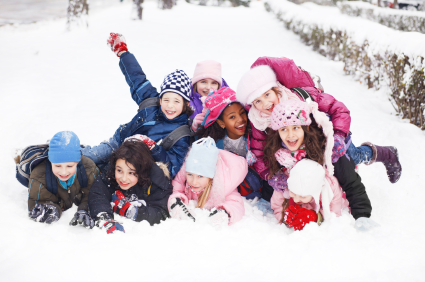Winter Safety Tips for Kids of All Ages

December 19, 2016
by Mankato Clinic
The snow is falling and mittens adorn the floor of mudrooms everywhere, which can only mean one thing; it’s winter in Minnesota.
Winter is the perfect season for the family to head outside to go skiing at Mount Kato or sledding at Sibley Park, but cold weather, ice and snow can also be dangerous for children.
With drastically low temperatures in the winter, hypothermia can occur. Hypothermia develops when body temperature falls below normal due to exposures to colder temperatures. It often happens when kids are playing outside in extremely cold weather without wearing proper clothing or when clothing gets wet. Hypothermia also occurs more quickly in children than in adults.
As hypothermia sets in, children will shiver and become clumsy and lethargic. Watch for speech that becomes slurred and a body temperature that declines. If you suspect your child is hypothermic call 9-1-1 immediately. Until help arrives, take the child indoors, remove any wet clothing and wrap them in blankets or warm clothes.
Like hypothermia, frostbite can also be a dangerous outcome of not being prepared for the temperatures. Occurring when the skin and outer tissues become frozen, frostbite tends to happen on fingers, toes, ears and nose. Extremities will also become pale, gray and blistered, and the child may complain that his/her skin burns or has become numb.
If frostbite occurs, bring the child inside and place the affected areas in warm – not hot – water. Warm washcloths may be applied to frostbitten nose, ears and lips. Do not rub the frozen areas. After a few minutes in warm water, dry and cover the child with clothing or blankets and give them something warm to drink. If the numbness continues for more than a few minutes call your doctor.
Just because it’s cold and snowy doesn’t mean that families should hibernate in the winter months, it just means that you should take extra precautions when it comes to enjoying the outdoors.
The American Academy of Pediatrics recommends parents brush up on the following tips for how to keep the whole family safe throughout the winter:
- Young children generate less body heat and get cold more quickly than adults. Dress infants and kids warmly for outdoor activities. Have them wear several thin layers that will keep them dry and warm. Don’t forget warm boots, mittens or gloves and a hat.
- For older babies and young children, a good rule of thumb to abide by is to dress them in one more layer of clothing than an adult would wear in the same situation.
- Quilts, pillows, blankets, sheepskins, bumpers and other loose bedding should be kept out of an infant’s sleeping environment because of their association with suffocation deaths and may contribute to Sudden Infant Death Syndrome. Instead, use sleep clothing like a one-piece sleeper or wearable blanket.
- Don’t send your child outside to play if the temperature or windchill is being reported as lower than -16 degrees. With such low temperatures, exposed skin will begin to freeze.
- Help children choose play areas with a warm shelter nearby (near home or a friend’s home).
- Even though it’s cloudy, you should still apply sunscreen to exposed skin.
- If your children’s hands and feet are warm, what they are wearing is usually good. If your child is dressed too warm, they could sweat and feel colder when they stop playing.
- Infants being pulled in a sled need extra bundling. Because they aren’t moving, they can’t generate body heat as well as a child playing can.